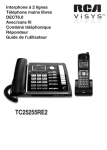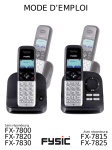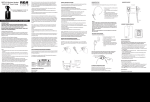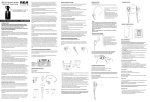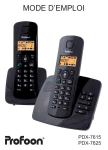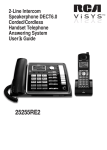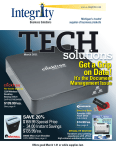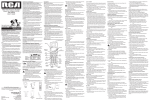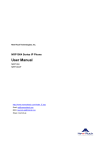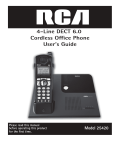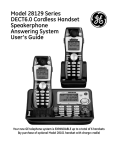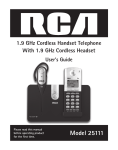Download RCA 25252 Instruction Manual
Transcript
DECT 6.0 2-Line Cordless Intercom Speakerphone with Digital Answering System User’s Guide Important Information Equipment Approval Information Your telephone equipment is approved for connection to the Public Switched Telephone Network and is in compliance with parts 15 and 68, FCC Rules and Regulations and the Technical Requirements for Telephone Terminal Equipment published by ACTA. 1 Notification to the Local Telephone Company On the bottom of this equipment is a label indicating, among other information, the US number and Ringer Equivalence Number (REN) for the equipment. You must, upon request, provide this information to your telephone company. The REN is useful in determining the number of devices you may connect to your telephone line and still have all of these devices ring when your telephone number is called. In most (but not all) areas, the sum of the RENs of all devices connected to one line should not exceed 5. To be certain of the number of devices you may connect to your line as determined by the REN, you should contact your local telephone company. A plug and jack used to connect this equipment to the premises wiring and telephone network must comply with the applicable FCC Part 68 rules and requirements adopted by the ACTA. A compliant telephone cord and modular plug is provided with this product. It is designed to be connected to a compatible modular jack that is also compliant. See installation instructions for details. Notes • This equipment may not be used on coin service provided by the telephone company. • Party lines are subject to state tariffs, and therefore, you may not be able to use your own telephone equipment if you are on a party line. Check with your local telephone company. • Notice must be given to the telephone company upon permanent disconnection of your telephone from your line. • If your home has specially wired alarm equipment connected to the telephone line, ensure the installation of this product does not disable your alarm equipment. If you have questions about what will disable alarm equipment, consult your telephone company or a qualified installer. US Number is located on the cabinet bottom REN number is located on the cabinet bottom Important Information 2 Rights of the Telephone Company Should your equipment cause trouble on your line which may harm the telephone network, the telephone company shall, where practicable, notify you that temporary discontinuance of service may be required. Where prior notice is not practicable and the circumstances warrant such action, the telephone company may temporarily discontinue service immediately. In case of such temporary discontinuance, the telephone company must: (1) promptly notify you of such temporary discontinuance; (2) afford you the opportunity to correct the situation; and (3) inform you of your right to bring a complaint to the Commission pursuant to procedures set forth in Subpart E of Part 68, FCC Rules and Regulations. The telephone company may make changes in its communications facilities, equipment, operations or procedures where such action is required in the operation of its business and not inconsistent with FCC Rules and Regulations. If these changes are expected to affect the use or performance of your telephone equipment, the telephone company must give you adequate notice, in writing, to allow you to maintain uninterrupted service. Interference Information This device complies with Part 15 of the FCC Rules. Operation is subject to the following two conditions: (1) This device may not cause harmful interference; and (2) This device must accept any interference received, including interference that may cause undesired operation. This equipment has been tested and found to comply with the limits for a Class B digital device, pursuant to Part 15 of the FCC Rules. These limits are designed to provide reasonable protection against harmful interference in a residential installation. This equipment generates, uses, and can radiate radio frequency energy and, if not installed and used in accordance with the instructions, may cause harmful interference to radio communications. However, there is no guarantee that interference will not occur in a particular installation. If this equipment does cause harmful interference to radio or television reception, which can be determined by turning the equipment off and on, the user is encouraged to try to correct the interference by one or more of the following measures: • Reorient or relocate the receiving antenna (that is, the antenna for radio or television that is “receiving” the interference). • Reorient or relocate and increase the separation between the telecommunications equipment and receiving antenna. • Connect the telecommunications equipment into an outlet on a circuit different from that to which the receiving antenna is connected. If these measures do not eliminate the interference, please consult your dealer or an experienced radio/television technician for additional suggestions. Also, the Federal Communications Commission has prepared a helpful booklet, “How To Identify and Resolve Radio/TV Interference Problems.” This booklet is available from the U.S. Government Printing Office, Washington, D.C. 20402. Please specify stock number 004-000-00345-4 when ordering copies. Important Information Warning: The changes or modifications not expressly approved by the party responsible for compliance could void the user’s authority to operate the equipment. Licensing Licensed under US Patent 6,427,009. Hearing Aid Compatibility This telephone system meets FCC standards for Hearing Aid Compatibility. FCC RF Radiation Exposure Statement This equipment complies with FCC RF radiation exposure limits set forth for an uncontrolled environment. This equipment should be installed and operated with a minimum distance of 20 centimeters between the base unit and your body. This transmitter must not be co-located or operated in conjunction with any other antenna or transmitter.” For body worn operation, this phone has been tested and meets the FCC RF exposure guidelines when used with the belt clip supplied with this product. Use of other accessories may not ensure compliance with FCC RF exposure guidelines. Information for DECT Product This telephone is compliant with the DECT 6.0 standard which operates in the 1.92GHz to 1.93GHz frequency range. Installation of this equipment is subject to notification and coordination with UTAM. Any relocation of this equipment must be coordinated through and approved by UTAM. UTAM may be contacted at 1-800-429-8826. 4 Table of Contents Set Office Time...........................................21 Equipment Approval Information................ 2 Set Work Hours........................................22 Interference Information........................... 3 Set After Hours.........................................22 Licensing................................................... 4 Ring Delay..................................................23 Hearing Aid Compatibility.......................... 4 Message Length..........................................23 FCC RF Radiation Exposure Statement....... 4 Call Screening...........................................23 Information for DECT Product.................. 4 Message Alert............................................23 Introduction.............................................. 7 Remote Password.......................................24 Parts Checklist......................................... 7 Restore Setting...........................................24 Telephone Jack Requirements..................... 7 Telephone Operation................................ 24 Installation............................................... 8 Making Calls with the Cordless Handset24 Digital Security System................................ 8 Making Calls in the Speakerphone mode Your cordless phone uses a digital security (from the base)......................................24 system to protect against false ringing, Making Call in the Speakerphone mode unauthorized access, and charges to your (from the handset)................................25 phone line.............................................. 8 Making Calls with the Optional Headset25 Important Installation Guidelines............... 8 Pre-dialing.................................................25 Handset Layout......................................... 9 Answering a Call.......................................25 Base Layout............................................ 10 Switching Between the Speakerphone, Installing the Phone................................ 11 Handset, and Headset Mode................26 Installing the Handset Battery................. 11 Base .....................................................26 Base Station...............................................12 Cordless Handset.................................26 Programming the Phone ......................... 14 Mute............................................................26 Standby Screen...........................................14 Do Not Disturb..........................................27 Programming Functions............................14 Flash...........................................................27 Phone Setting.............................................14 Inserting a Pause in the Dialing Sequence.... Date/Time....................................................15 27 Auto Answer (only applicable for handset)... Redial..........................................................27 15 Reviewing the Redial Numbers..................27 Auto Answer Intercom (applicable for base Storing a Redial Record in Phone Book..28 and handset)..........................................16 Transferring a Call to Another Extension... Dial Mode (only applicable for base)........16 28 Area Code (only applicable for base)........16 Receiving a Transferred Call from Another Registration (only applicable to handset)16 Extension...............................................28 Register.......................................................17 Ringer On/Off and Ringer Volume..........28 Remove Handset.........................................17 Speakerphone, Handset, and Headset De-Register (Only applicable for base).....17 Volume...................................................29 2nd Call Alert ..........................................18 Hold............................................................29 Handset Name (only applicable for handset)...... Conference Calls.......................................29 18 Join a call in progress:........................29 Update Handset List (only applicable for 3-way conference call by an intercom base).......................................................18 call:.......................................................29 Display Setting. ..........................................18 3-way conference call with two lines:.... Contrast.....................................................19 29 Backlight (Only applicable for base).........19 4-way conference call (Line 1 + Line 2 Sound Setting.............................................19 + 2 extension):.....................................29 Ring Volume...............................................20 Intercom Calls........................................ 30 Key Tone......................................................20 One-Touch Intercom..................................30 Answering System (only applicable for base)...... Answering an Intercom Call. ...................30 20 Page.............................................................30 On/Off Status............................................20 Auto Standby..............................................30 OGA Playback............................................21 Set OGA......................................................21 Table of Contents CALLER ID (CID) .................................... 31 RECEIVING AND STORING CID RECORDS.........31 REVIEWING CID RECORDS .............................31 SAVING A CID RECORD TO PHONE BOOK MEMORY.................................................32 DELETING A CID RECORD ..............................32 DELETING ALL CALL RECORDS ........................32 DIALING BACK ..............................................32 IF YOU PROGRAMMED YOUR LOCAL AREA CODE......................................................32 IF YOU DID NOT PROGRAM YOUR LOCAL AREA CODE ............................................33 CALL WAITING CALLER ID.............................33 MEMORY LOG AND PHONE BOOK (DIRECTORY) MEMORY .............................................. 33 ADDING PHONE BOOK ENTRIES ......................33 STORING RECORD IN ONE-TOUCH DIALING (ONLY APPLICABLE FOR BASE) ............................. 34 REVIEWING PHONE BOOK RECORDS ...............34 EDITING A PHONE BOOK RECORD ...................34 COPYING A PHONEBOOK RECORD ...................35 DELETING A PHONE BOOK RECORD ................35 DELETING ALL PHONE BOOK RECORDS ...........35 DIALING A PHONE BOOK RECORD ..................36 DIAL A PHONE BOOK RECORD WHILE IN TALK MODE: ....................................................36 DIAL A PHONE BOOK RECORD WHILE REVIEWING IT: .........................................36 ANSWERING SYSTEM OPERATION................... 36 ANSWERING SYSTEM ON/OFF ........................36 RECORDING INCOMING MESSAGES .................36 MONITORING INCOMING CALLS ......................37 MEMO RECORD.............................................37 MEMO RECORDING .......................................37 FROM THE ANSWER SYSTEM MENU: ........37 MESSAGEMEMO PLAYBACK............................37 6 ERASING MESSAGES .....................................38 TO ERASE A MESSAGE WHILE IT IS PLAYING 38 TO ERASE A MESSAGE AFTER IT PLAYING.....38 TO ERASE ALL PREVIOUSLY PLAYED MESSAGES IN A MAILBOX ..........................................38 REMOTE ACCESS FROM REMOTE PARTY ..........38 MEMORY FULL ..............................................39 CHANGING THE BATTERY.............................. 39 BATTERY SAFETY PRECAUTIONS ..................... 39 DISPLAY MESSAGES ................................... 40 HANDSET SOUND SIGNALS........................... 40 TROUBLESHOOTING GUIDE ............................ 41 TELEPHONE SOLUTIONS...................................41 NO DIAL TONE .........................................41 DIAL TONE IS OK, BUT CAN’T DIAL OUT ......41 HANDSET DOES NOT RING .........................41 YOU EXPERIENCE STATIC, NOISE, OR FADING IN AND OUT .................................................41 MEMORY DIALING DOESN’T WORK .............41 UNIT LOCKS UP AND NO COMMUNICATION BETWEEN THE BASE AND CORDLESS HANDSET ... 41 “OUT OF RANGE...” SHOWS IN THE HANDSET DISPLAY ...................................................41 DATE/TIME SETTING IS RESTORED TO DEFAULT SETTING ...................................................41 CALLER ID SOLUTIONS...................................42 NO DISPLAY............................................42 NO CALLER ID .......................................42 BATTERY........................................................42 GENERAL PRODUCT CARE ............................ 42 CAUSES OF POOR RECEPTION ....................... 43 WARRANTY ASSISTANCE .............................. 44 Connections & Setup Installation Digital Security System Your cordless phone uses a digital security system to protect against false ringing, unauthorized access, and charges to your phone line. INSTALLATION NOTE: Some cordless telephones operate at frequencies that may cause or receive interference with nearby TVs, microwave ovens, and VCRs. To minimize or prevent such interference, the base of the cordless telephone should not be placed near or on top of a TV, microwave ovens, or VCR. If such interference continues, move the cordless telephone farther away from these appliances. Certain other communications devices may also use the 1.9 GHz frequency for communication, and, if not properly set, these devices may interfere with each other and/or your new telephone. If you are concerned with interference, please refer to the owner’s manual for these devices on how to properly set channels to avoid interference. Typical devices that may use the 1.9 GHz frequency for communication include wireless audio/video senders, wireless computer networks, multi-handset cordless telephone systems, and some long-range cordless telephone systems. Important Installation Guidelines • Avoid sources of noise and heat, such as motors, fluorescent lighting, microwave ovens, heating appliances and direct sunlight. • Avoid areas of excessive dust, moisture and low temperature. • Avoid other cordless telephones or personal computers. • Never install telephone wiring during a lightning storm. • Never install telephone jacks in wet locations unless the jack is specifically designed for wet locations. • Never touch non-insulated telephone wires or terminals, unless the telephone line has been disconnected at the network interface. • Use caution when installing or modifying telephone lines. Connections & Setup Handset Layout Visual Indicator 3 Soft keys display DND/Privacy (button) Exit (button) VOL +/(buttons) Spk (Speaker button) Headset Jack CID (button) Off (button) DIR (button) Talk (button) * Tone (button) #Pause (button) Redial (button) Mute/Del (button) Int/Hold (button) Menu/Flash (button) 9 Connections & Setup Base Layout 10 the Telefield NA Inc. approved Nickel-metal Hydride (Ni-MH) battery model T-T104(GP, 2.4V, 500mAh) , which is compatible with this unit. Class ( Classe ) 2 Power source Connections & Setup 4. If you want to mount the telephone on the wall, you can plug the 2 lines such as the below drawing; Line 2 Line 1 -OR- Line 2 Line 1 -OR- Line 1 + 2 13 Answering SYS., Voice Mail Programming the Telephone Area Code (base only), Registration (handset only), De-Registration (base only), 2nd Call Alert (both base and handset), Handset Name (handset only), Update HS List (base only). Add Headset (base only) Date/Time From the Phone Setting Menu: 1. Press the VOL (- or +) button to scroll to Date/Time. 2. Press SELECT Soft key. 3. LCD will display last-set time (or, if the device is new or has been reset to default, the LCD will display 12:00AM 01/01/10) 4. Use the dial-pad to enter digits for the current time and date. Note: Use DIR/CID button to move the cursor and the AM/PM softkey to set the time AM or PM. 5. Press SAVE softkey to confirm the setting, a confirmation tone will indicate that your selection has been saved. NOTE: If you subscribe to Caller ID service, the current Date/Time is set automatically when you receive your first CID record and will override manually set Date/Time. NOTE: The Date/Time setting item only exists in base menu, handset Date/ Time should update automatically after it is set in the base. Auto Answer (only applicable for handset) This option allows you to pick up the handset from base to answer an incoming call without pressing the Talk/Spk/L1/L2 button. When it is set to off, this function is disabled in this handset. From the Phone Setting Menu: 1. Press the VOL (- or +) button to scroll to the Auto Answer. 2. Press SELECT soft key. Use the VOL (- or +) button to scroll to your selection. The default setting is Off. 3. Press SELECT soft key to save your selection. 15 Programming the Telephone Auto Answer Intercom (applicable for base and handset) If it is set to on, this handset or base will auto answer the intercom call when it receives an intercom call. From the Phone Setting Menu: 1. Press the VOL (- or +) button to scroll to Auto Answer Int. 2. Press SELECT soft key. Use the VOL (- or +) button to scroll to your selection. The default setting is Off. 3. Press SELECT soft key to save your selection . Dial Mode (only applicable for base) The Dial Mode of Line 1 and Line 2 can be set separately. From the Phone Setting Menu: 1. Press the VOL (- or +) button to scroll to the Dial mode. 2. Press SELECT soft key. 3. Use the VOL (- or +) button to select Tone or Pulse and use the DIR or CID button to select L1 or L2. 4. Press SELECT soft key to save your selection . NOTE: The Dial mode only can be set in the base menu. Area Code (only applicable for base) The telephone uses the pre-programmed area code to determine the number format to display when a valid Caller ID record is received. The preprogrammed area code is also used for the Dialback feature. From the Phone setting Menu: 1. Press the VOL (- or +) button to scroll to the Area code. 2. Press SELECT soft key. 3. Use the touch-tone pad to enter your 3-digit area code. 4. Press SAVE soft key to save your selection . Registration (only applicable to handset) A cordless handset will not operate until it is registered to the base. During the registration process, keep the handset near the base. Up to 10 cordless handsets can be registered to one base. NOTE: If a handset has not been registered to the base, then the display will show “PRESS “REG” TO INITIATE REGISTRATION” once the handset has been activated. Press the REG soft key to start the registration. From the Phone Setting Menu: 1. Press the VOL (- or +) button to scroll to Registration. 2. Press SELECT soft key and you may program the following items: Register and Remove handset. 16 Programming the Telephone Register From the Phone Setting Menu: 1. Press the VOL (- or +) button to scroll to Register. 2. Press SELECT soft key. Register HS Registering... shows in the display. 3. Press and hold the Page button on base for about 3 seconds 4. “Registering” displays to indicate the base is now in registration mode. 5. If the registration is successful, the handset shows “Registration complete” for 2 seconds and emits a confirmation tone. 6. If the registration is failed (i.e. timeout), the handset shows “REGISTRATION FAILED!” for 2 seconds and emits an error tone. Remove Handset De-registration cancels registration. During the de-registration process, keep the handset near the base. WARNING: It is not recommended that a handset be deregistered unless absolutely necessary because once a handset is deregistered, that handset’s telephone features cannot be used until the handset is re-registered. From the Phone Setting Menu: 1. Press the VOL (- or +) button to scroll to the Remove handset. 2. Press SELECT soft key. “Remove handset?” shows on the display. 3. Press the YES soft key to confirm de-registration. then shows “Press “REG” to initiate registration” in the handset. NOTE: You can press the REG soft key to enter the registation mode again. De-Register (Only applicable for base) From the Phone Setting Menu: 1. Press the VOL (- or +) button to scroll to the Deregistration. 2. Press SELECT soft key. The list of all registered handsets will be shown, and use the VOL (- or +) button to scroll to your selection. 3. Press the SELECT soft key. “Remove handset?” shows on the display. Press YES soft key to confirm de-registration. base emit a confirm tone then shows “Press “REG” to initiate registration” in the handset. Add Headset (only applicable for base) NOTE: This wireless headset option is only compatible with the RCA 25065RE1, 25265RE2 and 25270RE3 headsets. From the Phone Setting Menu: 1. Press the vol(- or +) button to scroll to Add Headset; 2. Press the SELECT Sofykey. The screen will display Pairing...Please wait. 3. On the headset, press and hold the Talk On/Off button together with the Volume+ button for 3 seconds. The LED indicators will begin blinking in an alternate red and blue pattern. 4. If the registration is successful, a blue LED on the Headset will flash. NOTE: Only one cordless Headset may pair with a base unit. 17 Programming the Telephone 2nd Call Alert If it is set to On, you will hear the alert tone when you are in conversation and there is an incoming call from another line. From the Phone Setting Menu: 1. Press the VOL (- or +) button to scroll to 2ND Call Alert. 2. Press SELECT soft key. Use the VOL (- or +) button to scroll to your selection. The default setting is On. 3. Press SELECT soft key to save your selection . Handset Name (only applicable for handset) From the Phone Setting Menu: 1. Press the VOL (- or +) button to scroll to the Handset name. 2. Press SELECT soft key. The default name is Handset. 3. Use the touch-tone pad to enter a name (up to 13 characters). More than one letter is stored in each of the number keys. For example, to enter Bill Smith, press the 2 key twice for the letter B. Press the 4 key 3 times for the letter I. Press the 5 key 3 times for the letter L. Press the 5 key 3 times for the second letter L, and press the 1 key to insert a space between the first and last name. Press the 7 key 4 times for the letter S; press the 6 key once for the letter M; press the 4 key 3 times for the letter I; press the 8 key for the letter T; press the 4 key twice for the letter H. NOTE: If you make a mistake, press DIR/CID button to move the cursor forward or backward, and then use the Mute/Del button to backspace and delete one character at a time. 4. Press the SAVE soft key to save your name. You will hear a confirmation tone . Update Handset List (only applicable for base) This function is used to update all registered handsets from the current handset name list. From the Phone Setting Menu: 1. Press the VOL (- or +) button to scroll to the Update HS List. 2. Press SELECT soft key. 3. The latest handset name list stored in the base will be sent to all registered handsets. Display Setting 1. Make sure your phone is OFF (not in Talk mode). 2. Press the Menu button on HS or the MENU soft key on BS to go to the main menu. 3. Press VOL (- or +) button to scroll to Display Setting. 4. Press SELECT soft key to confirm and you may program the following items: Language, Contrast and Backlight (base only). 18 Programming the Telephone Language From the Display Setting Menu: 1. Press the VOL (- or +) button to scroll to the Language. 2. Press SELECT soft key. 3. Use the VOL (- or +) button to select English, Francais or Espanol. The default setting is English. 4. Press SELECT soft key to save your selection. Contrast From the Display Setting Menu: 1. Press the VOL (- or +) button to scroll to the Contrast. 2. Press SELECT soft key. The “MIN and MAX” contrast scale shows on the display. 3. Use the VOL (- or +) button to adjust the contrast. The display instantly adjusts with each press of the VOL (- or +) button. 4. Press SELECT soft key to save the desired contrast level. Backlight (Only applicable for base) From the Display Setting Menu: 1. Press the VOL (- or +) button to scroll to the Backlight. 2. Press SELECT soft key and use the VOL (- or +) button to select Always On or Automatic. 3. Press SELECT soft key to save your selection. Sound Setting 1. Make sure your phone is OFF (not in Talk mode). 2. Press the Menu button on HS or the MENU soft key on BS to go to the main menu. 3. Press VOL (- or +) button to scroll to Sound Setting. 4. Press SELECT soft key to confirm and you may program the following items in base and handset: Ring Tone, Ring Volume and Key Tone. Ring Tone There are 8 tone levels for your selection. They are Melody 1 to 8 for line 1 and line 2 respectively. From the Sound Setting Menu: 1. Press the VOL (- or +) button to scroll to the Ring Tone. 2. Press SELECT soft key. 3. Use the VOL (- or +) button to select Line1 or line2, press Select softkey to confirm,then use VOL(- or +) to scroll to your selection.The default setting is Melody 1 for line1 and Melody 2 for line2. 4. Press SELECT soft key to save your selection . Ring Volume There are 5 volume levels and OFF for your selection. The Ring volume can be set individually for each line. From the Sound Settings Menu: 1. Press the VOL (- or +) button to scroll to the Ring Volume. 19 Programming the Telephone 2. Press SELECT soft key. 3. Use the VOL (- or +) button to select Line1 or line2, press Select softkey to confirm,then use VOL(- or +) to scroll to your selection. The default setting. is VOL 3. 4. Press SELECT soft key to save your selection. Key Tone From the Sound Settings Menu: 1. Press the VOL (- or +) button to scroll to the Key Tone. 2. Press SELECT soft key. Use the VOL (- or +) button to select On or Off. 3. Press SELECT soft key to save your selection. Voice Mail This feature is used to conveniently access the voicemail feature offered by your telephone service provider. NOTE: You must subscribe to telephone service provider-offered voicemail on at least one phone line in order for this feature to operate. 1. Make sure your phone is in idle mode. (not in Talk mode) 2. Press the MENU Soft key (left) to go to the main menu. 3. Press VOL (- or +) button to scroll to Voice Mail. 4. Press SELECT Soft key (right) to confirm and you may program the following items: Call VM Settings Call VM From the Voice Mail Menu: 1. Press VOL (- or +) button to scroll to Call VM. 2. Press SELECT Soft key 3. Use the VOL (- or +) button to toggle between Line 1 and Line 2 and press SELECT soft key to select. 4. The phone will dial your voicemail access number. You may proceed to access your voicemail per your service provider’s instructions. Settings From the Voice Mail Menu: 1. Press VOL (- or +) button to scroll to Settings. 2. Press SELECT Soft key 3. Use the VOL (- or +) button to toggle between Line 1 and Line 2 and press SELECT soft key to select. 4. Use the dial pad to enter the call-in access number for your voicemail. Press Delete button to backspace and delete numbers, if necessary. 5. Press SAVE Soft key. 6. A confirmation tone will indicate that your selection has been saved. Answering System (only applicable for base) 1. Make sure your phone is OFF (not in Talk mode). 2. Press the MENU soft key on BS to go to the main menu. 3. Press VOL (- or +) button to scroll to “Answer Sys.”. 4. Press SELECT soft key to confirm. You may program the following items in base: On/Off Status, OGA Playback, OGA Record, Set OGA, Set Office Time, Ring Delay, Message Length, Call Screening, Message Alert, Remote Password. 20 Programming the Telephone On/Off Status This is used to set the answering system On or Off for each telephone line individually. From the Answering System Menu: 1. Press the VOL (- or +) button to scroll to the On/Off Status. 2. Press SELECT soft key. 3. Use the VOL (- or +) button to select Line1 or Line2, press select softkey and then use Vol(- or +) button to select On or Off. 4. Press the SELECT soft key to save your selection and the status shows in the display. OGA Playback From the Answering System Menu: 1. Press the VOL (- or +) button to scroll to the OGA Playback. 2. Press SELECT soft key. 3. Use VOL(- or+) to select Line1 or Line2, press select softkey and then use Vol(- or +) button to select the direct OGA record. 4. Press SELECT soft key to play the selected OGA, if the selected OGA is empty, “EMPTY” shows in the display. OGA Record From the Answering System Menu: 1. Press the VOL (- or +) button to scroll to the OGA Record. 2. Press SELECT soft key. 3. Use VOL(- or+) to select Line1 or Line2, press select softkey and then use Vol(- or +) button to select the direct OGA. 4. Press the SELECT soft key to record. After the beep, you can start to record. 5. Press the FINISH soft key to end the recording. 6. After recorded, the unit will automatically play the OGA once. Set OGA From the Answering System Menu: 1. Press the VOL (- or +) button to scroll to the Set OGA. 2. Press SELECT soft key. 3. Use VOL(- or+) to select Line1 or Line2, press select softkey and then use Vol(- or +) button to select the direct OGA record. 4. Press the SELECT soft key to save your selection. If there is not a message recorded in your selected greeting, “EMPTY” shows in the display and you should select another one. Otherwise. NOTE: If you select the option “TIMED” when there is an incoming call, the “Work Hours” OGA or “After Hours” OGA will be played to the caller according to the office time you set. Set Office Time From the Answering System Menu: 1. Press the VOL (- or +) button to scroll to the Set Office Time. 2. Press SELECT soft key. You can program the following items: Work Hours and After Hours. 21 Programming the Telephone Set Work Hours This will allow you to program the start time for the working hour. From the Answering System Menu: 1. Press the VOL (- or +) button to scroll to the Set Work Hours. 2. Press SELECT soft key. 3. Use the touch-tone pad to set the time, and use AM/PM soft key to select AM or PM. 4. Press the SELECT soft key to save the time. 5. Use the VOL (- or +) button to select Yes or No for Announce Only. 6. Press the SELECT soft key to save your selection. NOTE: If you select Yes for Announce Only, the unit will hang up the call after announcing the greeting when answering the call is in answering mode. Set After Hours This will allow you to program the start time for the after work hour. From the Answering System Menu: 1. Press the VOL (- or +) button to scroll to the Set After Hours. 2. Press SELECT soft key. 3. Use the touch-tone pad to set the time, and use AM/PM soft key to select AM or PM. 4. Press the SELECT soft key to save the time. 5. Use the VOL (- or +) button to select Yes or No for Announce Only. 6. Press the SELECT soft key to save your selection . NOTE: If you select Yes for Announce Only, the unit will hang up the call after announcing the greeting when answering the call is in answering mode. Example: a) Set the Work Hours start at 9:00am, and “Announce Only” as NO. b) Set the After Hours start at 5:00pm, and “Announce Only” as NO. c) Select “Timed” while setting the OGA. When the call comes in within 9:00am to 5:00pm, the Work Hours OGA will be announced to the caller. When the call comes in after 5:00pm up to 9:00am, the After Hours OGA will be announced to the caller. On Saturdays and Sundays, the unit will announce After Hours OGA. 22 Programming the Telephone Ring Delay This feature lets you select the number of times you want the phone to ring before the answering system answers a call. From the Answering System Menu: 1. Press the VOL (- or +) button to scroll to the Ring Delay. 2. Press SELECT soft key. 3. Use VOL(- or+) to select Line1 or Line2, press select softkey and then use Vol(- or +) button to select from 2 rings to 6 rings or toll saver. 4. Press the SELECT soft key to save your selection . NOTE: When the Toll saver is selected, the unit will answer the incoming call after 3 rings if there is new message. Otherwise, the unit will answer the incoming call after 5 rings. Message Length From the Answering System Menu: 1. Press the VOL (- or +) button to scroll to the Message Length. 2. Press SELECT soft key. 3. Use VOL(- or+) to select Line1 or Line2, press select softkey and then use Vol(- or +) button to select from 1 to 3 minutes. 4. Press the SELECT soft key to save your selection. Call Screening From the Answering System Menu: 1. Press the VOL (- or +) button to scroll to the Call Screening. 2. Press SELECT soft key. Use the VOL (- or +) button to select On or Off. 3. Press the SELECT soft key to save your selection. Message Alert This feature set your answering system to give an alert tone every 10 seconds when there are new messages. From the Answering System Menu: 1. Press the VOL (- or +) button to scroll to the Message Alert. 2. Press SELECT soft key. Use the VOL (- or +) button to select On or Off. Default is On. 3. Press the SELECT soft key to save your selection. 23 Telephone Operation Remote Password You can access the answering system from a tone dialing telephone in another (remote) location. The security code is required for remote access, and it prevents unauthorized access to your answering system. From the Answering System Menu: 1. Press the VOL (- or +) button to scroll to the Remote Password. 2. Press SELECT soft key. The current Remote password shows in the display. Default is 000. 3. Use the touch-tone pad to enter your 3-digit security code. 4. Press SELECT soft key to save the setting. Restore Setting The feature allows you to reset some menu settings to the original default settings. From the Answering System Menu: 1. Press Menu button on handset or MENU soft key on the base. 2. Press the VOL (- or +) button to scroll to Restore Setting. 3. Press SELECT soft key. “LOAD TO DEFAULT?” displays on the screen. 4. Press YES soft key to let unit reset to default setting; once finished, the unit will emit a short beep prompt, and then reset the unit automatically after the base shows " please wait..." in the display for about 3 seconds. 5. If you do not want to reset, press the NO soft key. Telephone Operation Making Calls with the Cordless Handset 1. Press the Talk button, the unit will pick the first available line for you. -ORPress Line 1 or Line 2 soft key to select a line you wanted. 2. Wait for a dial tone then dial the phone number. 3. Press the End button when finished. Making Calls in the Speakerphone mode (from the base) 1. Press the Speaker button (in base), the unit will pick the available line for you. If both lines are available, Line 1 will be used first. -ORPress Line 1 or Line 2 button on the base to select the line, and the base’s speaker will activate. 2. Wait for a dial tone then dial a phone number or press One-Touch button (1-10) to dial stored phone number. 3. Press the Speaker button when finished. NOTE: After pick the line, the call timer starts to run until all the calls are hung up. The timer serves for both 2 lines. 24 Press the Line1 or Line2 Softkey to select a specific line. The Handset will activate the ear piece. Then press the SPK button to switch to the speakerphone mode. 2 3 a wired CAUTION: For servicing or replacement, you can purchase a suitable headset through service centre or retailer shop. Note: Although this device will accept a variety of standard 2.5mm telephone headsets, RCA does not guarantee compatibility with 3rd party devices. Performance may vary depending on the quality of the headset. Telephone Operation For the base: 1. Press the Speaker button to answer the call in speakerphone mode, -OR- 2. Press the corresponding Line button to answer the call in speakerphone mode, -OR- 3. Press the Headset button to answer the call in headset mode. 4. When finished, press Speaker button (in speakerphone) or Headset button (in headset mode) to end the call. NOTE: If you have set the Auto Answer as On in the cordless handset, you can answer the call directly by picking up this handset from the base, without pressing any buttons. NOTE: Adjust the volume by pressing the VOL (- or +) button during a call. Switching Between the Speakerphone, Handset, and Headset Mode Base To switch to the speakerphone, press Speaker button. The speakerphone indicator illuminates. To switch to the headset, press the Headset button to enable the headset, and the headset indicator illuminates. Cordless Handset To switch to the speakerphone, press Spk button. If the headset is plug in, press Talk button to switch to headset. If the headset is not plug in, press Talk button to switch to cordless handset’s receiver. Mute To have a private, off-line conversation, use the Mute feature. The party on the other end of the line cannot hear you, but you can still hear them. 1. Press Mute button to activate the mute feature. NOTE: When using the mute feature on the base, the indicator will illuminate when the mute is activated. 2. Press the Mute button again to de-activate. 26 Telephone Operation Do Not Disturb This feature is set at individual telephones to disable (silence) an incoming ring signal, intercom ring. When there is an incoming call or an intercom call, the status indicators function as normal but the phone will not ring. 1. When the unit is idle, press the DND/Privacy button. The last setting is displayed. 2. Use the VOL (- or +) button to select the duration. You may choose from 15 minutes, 30 minutes, 45 minutes, 1 hour, or 2 hours and increase the duration by 1-hour intervals up to 24 hours. 3. Press the SELECT soft key to confirm. The indicator (on the base) blinks and the display shows how long the ringer will be disabled. 4. To cancel, press DND/Privacy button again. NOTE: If Intercom Auto Answer is activated, the unit automatically answers the intercom call even if the Do Not Disturb function is activated. Flash Use the Flash button to activate custom calling services such as call waiting or call forwarding, which are available through your local phone company. Inserting a Pause in the Dialing Sequence Press the #pause button twice to insert a delay in dialing sequence when a pause is needed to wait for a dial tone (for example, after you dial 9 for an outside line, or to wait for a computer access tone.) Each pause counts as one digit in the dialing sequence, and is shown as “P” in the display. Redial 1. Press the Talk button, or press the Speaker button (speakerphone mode), or press the Headset button (headset mode) and the first available line will go off hook. If both lines are available, Line 1 will be used. -ORPress a Line button to select a line. 2. Press the Redial button. The redial number list (last 3 previously dialed numbers) is shown. 3. Use the VOL (- or +) button to select the number. Press the DIAL soft key to dial out the number. NOTE: The Redial function will not operate if the number to be redialed contains more than 32 digits. If the number is longer than that, you will hear an error tone. Reviewing the Redial Numbers Your phone records up to three previously dialed phone numbers. 1. When the phone is idle, press the Redial button. 2. Use the VOL (- or +) button to view the last three previously dialed numbers. 3. While the preferred number is displayed, press the Spk, Talk, or a Line button to dial the phone number. 27 Telephone Operation NOTE: If you do not select a Line button, the line is automatically seized and the number is dialed accordingly. Storing a Redial Record in Phone Book 1. Make sure the phone is OFF (not in Talk mode). 2. Press the Redial button, then use the VOL (- or +) button to scroll to the desired redial number. 3. Press the SAVE soft key. 4. “Enter Name” shows in the display. Input a name. Please refer to section “Handset Name” for name editing method. NOTE: A name must be input otherwise the record cannot be stored. 5. Press the SAVE soft key. The desired redial number shows in the display. 6. You can edit the telephone number. 7. Press SAVE soft key to enter the VIP Tone Melody selection. Transferring a Call to Another Extension 1. Press XFER soft key when the phone is in Talk mode. 2. Use VOL (- or +) to select the desired handset or base you want to transfer to, and then press the SELECT soft key. 3. The unit will intercom the selected handset or base, and it will ring for this intercom call. At this moment, the call is on hold. 4. Once the selected handset answers the intercom call, after the call transfer initialized unit hangs up, the call can be transferred to the desired handset or base, or press the CONF soft key to enter conference call mode. 5. If the selected unit rejects the intercom call, the call transfer initialized unit shows ”Unavailable” in the display for 3 seconds, and then you can pick up the call again. Receiving a Transferred Call from Another Extension If the unit receives a transfer call paging, “Intercom call from base/Handset X” shows in the display. Press the Talk button (handset only) or Speaker button (both base and handset) to answer the call. If you press the REJECT soft key, the intercom paging will be stopped. Ringer On/Off and Ringer Volume 1. Make sure the phone is in idle mode. 2. Press the VOL (- or +) button to activate the ringer volume setting. Press Line1 or Line2 softkey to select the direct line which you want to set, then use the VOL (- or +) button to scroll to your selection. The default setting is VOL 3. 3. Press the SELECT soft key to save your selection. NOTE: If you choose the ringer OFF, “L1/L2 RINGER OFF” shows in the display. 28 Telephone Operation Speakerphone, Handset, and Headset Volume While the phone is in use, during the desired mode, press the VOL (+ or -) buttons until you reach a comfortable listening level. The phone stores the setting after the last button pressed. Hold In Talk mode, press the Hold button to hold the line. “Line X ON HOLD” shows in the LCD display, and the line icon will flash. On the base, the Line button indicator will flash also. When the line is on hold, the hold alert tone will be emitted. Press the corresponding LINE soft key (on handset), or the Line button (on base) to release the hold and pick up the call again. Conference Calls This system can support 3-way and 4-way conference calls. Join a call in progress: 1. While a call is in progress, another user can join that call by pressing the corresponding Line button on the base unit or soft key in the handset. Both parties on the original call will hear a tone to alert them someone else has joined the call. NOTE: If the privacy feature is On for the original call, the call cannot be joined by another user. 3-way conference call by an intercom call: 1. While on a call, press the Intercom button, wait for timer to clear from the screen, press the Intercom button again and then select the desired handset or base to intercom. 2. The selected handset or base will emit a page tone. The user can press the Talk button on the handset or the Speaker button on the base to answer the intercom call page. 3. The originating caller can then press the CONF soft key shown on the display to establish a 3-way conference between the external caller and the intercom call. 3-way conference call with two lines: 1. During a call on Line 1, press the Hold button to put the call on hold. 2. Press the Line 2 button or soft key on the handset to get a dial tone. Dial the number, and then talk to the other person. 3. The originating caller can then press the CONF soft key shown on the display to establish a 3-way conference between the two lines. 4-way conference call (Line 1 + Line 2 + 2 extension): 1. Once the base unit or handset has both Line 1 and 2 on hold, press the Intercom button and then select the desired handset or base to intercom. 2. The selected handset or base will emit a page tone. The user can press the Talk button on the handset or the Speaker button on the base to answer the intercom call page. 29 Intercom Calls 3. The originating caller can then press the CONF soft key shown on the display to initiate a conference. Since Line 1 and 2 are both on hold, the user will be prompted to select Line 1, Line 2 or Both to conference with. The user can then use the soft keys to select the desired option. If the BOTH soft key is selected a 4-way conference is established between the originating caller, both lines and the intercom call. Intercom Calls One-Touch Intercom 1. On the base, in idle mode, press any One-Touch Intercom button (110) for the station you want to intercom with. One-Touch button #1 represents handset 01, #2 represents handset 02, etc. The Intercom paging ring will be emitted. You may press the Intercom button, then press the Intercom/Memory button (1-10) for the stations you want to intercom with. -OR- -OR- Press the Intercom button, and all the registered handsets and the base except itself list in the log, use the VOL (- or +) key to scroll to the station you want to intercom with, and then press SELECT soft key to confirm. NOTE: To abort intercom call, press the STOP soft key. NOTE: If the receiving station does not answer within 30 seconds, the intercom call is cancelled. You will hear an error tone and “Unavailable” shows in the display. Answering an Intercom Call When you receive an Intercom call, the display shows the Caller’s Name and Phone ID. If you want to answer with the speakerphone, press the Speaker button. If you want to answer by headset, press the Headset button on the base or the Talk button on the handset. The headset must be already connected. If you do not want to answer this intercom call, press the REJECT soft key. Page The page feature helps you locate a misplaced handset. 1. Press the Page button on the base. The handset beeps and the Visual Indicator on the handset flashes. “Paging from Base” shows in the handset display. 2. To cancel the page, press the Page button on the base, or press STOP soft key on the base, or press Exit key on the base, or press any key on the handset. Otherwise the paging will last for 2 minutes. Auto Standby If you place the handset in the cradle while the handset is off the hook (during a call), the call is automatically disconnected. 30 Caller ID Caller ID (CID) IMPORTANT: In order to use this unit’s Caller ID features, you must subscribe to either the standard Name/Number Caller ID Service or Call Waiting Caller ID Service. To know who is calling while you are on the phone, you must subscribe to Call Waiting Caller ID Service. When the unit receives an incoming call with CID information, the CID can be shown on the base and handsets. Base Display L1 LINE1 LINE2 Handset Display Receiving and Storing CID Records This unit receives and displays information transmitted by your local phone company. This information can include the phone number, date and time; or the name, phone number, date and time. The unit can store up to 99 records for later review. When the memory is full, a new call automatically replaces the oldest call in memory. “NEW” appears in the display for calls received that have not been reviewed. The line number for the call received is also displayed. If two incoming calls come in at the same time, the line1 and line2 phone numbers shows on the display separately. Reviewing CID Records • Press CID button, and then use the VOL (- or +) button to scroll through the call records. • When you scroll to the start/end of the list, the unit emit a warning tone and then scroll to the end or the start of the record. • When reviewing the CID records, the record number is also shown to the right of the time along with the FORMAT and STORE soft keys. 31 Caller ID Saving a CID Record to Phone Book Memory 1. While viewing a CID record, press the STORE soft key. 2. The name shows in the display. You can edit it. After editing, press the SAVE soft key. 3. The number shows in the display. You can edit it. After editing, press the SAVE soft key. 4. You can select the ring melody for this phone number. Use the VOL (- or +) button to scroll to your selection, and then press the SELECT soft key to save. NOTE: If you want to change the format of the CID number and save it in the phonebook, press the FORMAT soft key to format the CID number first before pressing the STORE soft key. NOTE: You cannot skip the name editing. If it is empty in the name field, you cannot press the SAVE soft key to go to number editing. Deleting a CID Record Press the Delete button to delete the record shown in the display. “DELETE?” shows in the display. Press the OK soft key to confirm. The unit will emit a confirm tone. Deleting All Call Records This feature allows you to clear all CID records at once. 1. While viewing a CID record, press and hold the Delete button. “Delete All ?” shows in the display. 2. Press OK soft key to confirm. A confirm tone emit and Empty shows for 3 seconds. Dialing Back When reviewing CID records, you can dial back the numbers showing on the display by pressing the Headset button, or the Talk button, or the Spk button or the Line 1 or Line 2 button. If You Programmed Your Local Area Code 1. Use the CID button to display the number you want to dial. 2. If you see a number with 7 digits (i.e. 555-1234), then the call was received from within your area code. However, this does not guarantee the call is a local call. If you see a number with 11 digits (i.e.1-234-555-1234), then the call received was not from your area code. 3. To adjust the phone number format, use the FORMAT soft key. For instance, a 7-digit local number sometimes cannot be dialed because it requires a 10-digit or 11-digit format. Use the FORMAT soft key to scroll through 7, 10 and 11-digit numbers. 32 Memory Number of digits 7-digits: Explanation Example 7-digit telephone number (i.e.555-5555) 10-digits: 3-digit area code +7-digit telephone number 11-digits: long distance code 1 (i.e. 1-425-555-5555) +3-digit area code +7-digit telephone number (i.e.425-555-5555) 4. To dial the displayed number, select a Line or press Talk, Spk, or Headset button. If You Did Not Program Your Local Area Code 1. Use the CID button to display the number you want to dial. You will only see 10-digit numbers (i.e. 234-555-1234). 2. Press Talk, Spk, Headset button or select a Line to dial back. You may adjust the number format by pressing the FORMAT soft key before dialing. Call Waiting Caller ID This feature allows you to see who is calling when you hear the call waiting beep. The caller identification information appears in the display after you hear the tone. • Press the Flash button to put the person to whom you’re talking on hold and answer the incoming call. IMPORTANT: To use all the features of this unit, you must subscribe to either the standard Name/Number Caller ID Service or Caller ID with Call Waiting Service. To know who is calling while you are on the phone, you must subscribe to Caller ID with Call Waiting Service. Memory Log and Phone Book (Directory) Memory You may store data in the Phone Book Directory (up to 99 records) or an Intercom/Memory (10 buttons located to the right of the number pad on the base). The Phone Book and each Intercom/Memory Log stores up to 16 characters and 32 digits. The records are stored by alphabetic ascending order. Adding Phone Book Entries 1. Make sure the phone is OFF (not in Talk mode). 2. Press the DIR button. 3. Press the NEW soft key. “Enter Name” shows in the display. Please refer to section “Handset Name” for name editing method. 4. Press SAVE soft key. “Enter Number” shows in the display. 5. Use the touch-tone pad to input a telephone number. TIP: Press the #pause button twice to insert a pause in a number if necessary. 6. Press the SAVE soft key to enter VIP tone melody selection. 33 Memory 7. Use VOL (- or +) button to scroll to the selection and press SELECT soft key to complete. NOTE: If “Memory full” shows in the display, you should delete one or more unnecessary records and repeat above steps to continue the call record storage. Storing Record in One-Touch Dialing (Only applicable for base) 1. Make sure the phone is OFF (not in Talk mode). 2. Press STORE soft key. 3. “Select Button Location” shows in the display. Press a One-Touch button (1-10) to save the record in that memory location. NOTE: If there is a record stored in selected memory location. Press REPLAC soft key to confirm overwrite or press the BACK soft key, then repeat the step 1~3 to select a new location. 4. “Enter Name” shows in the display. 5. Use the touch-tone pad to enter a name. NOTE: More than one letter is stored in each of the number keys so it requires more than one press for some letters. For example, for the letter “B” press the number 2 key twice. To add a space press the 1 key. 6. Press SAVE soft key. “Enter Number” shows in the display. 7. Use the touch-tone pad to input a telephone number. TIP: Press the #pause button twice to insert a pause in a number if necessary. 8. Press the SAVE soft key to save. Reviewing Phone Book Records 1. Make sure the phone is OFF (not in Talk mode). 2. Press the DIR button. 3. Press the VOL (- or +) button to scroll through the records, -ORPress the number keys to go to the name of the records started with the corresponding character. 4. Then you can press Menu softkey and then use VOL(- or +) to select View to review the direct record. Editing a Phone Book Record 1. When reviewing the phone book records, use the VOL (- or +) button or the number keys to scroll to the desired record. 2. Press EDIT soft key to enter edit mode. You may now change the name, if desired. Please refer to section “Handset Name” for name editing method. 3. Press SAVE soft key to proceed to number change. You may now change the number, if desired. 4. Press SAVE soft key to proceed to VIP Tone Melody selection. You may use VOL (- or +) key to scroll to the selection you desired. 34 Memory 5. Press SELECT soft key to complete. NOTE: Press the BACK soft key to keep the previous setting (making no changes). Copying a Phonebook Record You can copy one phone book record or the whole phone book from the handset extension to the base or from the base to desired handset extension. In the extension handset: 1. While viewing the phone book record, press the COPY soft key. 2. “Copy Current Record or Entire Directory?” shows in the display. Press the CURR soft key to copy the current record or press the ENTIRE soft key to copy the whole phone book. 3. After copying is finished, the prompt message “Record Copied to Base Unit!” shows in the display. In the Base Unit: 1. While viewing the phone book record, press the COPY soft key. 2. “Copy Current Record or Entire Directory?” shows in the display. Press the CURR soft key to copy the current record or press the ENTIRE soft key to copy the whole phone book. 3. The extension list will be shown. Use the VOL (- or +) button to select the desired extension handset for the record to be copied to. 4. Press the SELECT soft key. 5. After copying is finished, Record Copied!” shows in the base display, and “Saved” shows on the handset display. Deleting a Phone Book Record 1. When reviewing the phone book records list, use the VOL (- or +) button or the number keys to scroll to the desired record. 2. Press the delete key on the phone to delete the record. 3. “Delete?” shows in the display. 4. Press the OK soft key to confirm the deletion. Deleting All Phone Book Records 1. Press the DIR button to activate the phone book record list. 2. Press and hold the Delete button on the phone until “DELETE ALL?” shows in the display. 3. Press the OK soft key to confirm the deletion. 4. “Empty” shows in the display. 35 Answering System Operation Dialing a Phone Book Record Dial a phone book record while in Talk mode: 1. Make sure the phone is ON (in Talk mode) by pressing the Talk, Spk button, or selecting a Line. 2. Press the DIR button to access the phone book. 3. Use the VOL (- or +) button or the number keys to scroll to the desired record. 4. Press the DIAL soft key to dial the number. -ORDial a phone book record while reviewing it: 1. Make sure the phone is OFF (not in Talk mode). 2. Press the Phonebook button to access the phone book. 3. Use the VOL (- or +) button or the number keys to scroll to the desired record. 4. Press the Talk or Spk button on the handset or press the Speaker or Line 1/2 on the base. The number dials automatically. Answering System Operation There are two mailboxes in the system. One is for Line 1 and another is for Line 2. For memo recording, you can select which mailbox is used to record the memo. Answering System On/Off Press and hold the base Ans Sys button for 2 seconds, the Base unit will show the On/Off Status menu, setting the On/off status please refer to the Answering On/Off section. The Answering system light illuminates when the function is activated. If the Ans Sys button indicator is flashing, pressing it will go to the Play Message display. Otherwise, pressing the button will display Line 1 and Line 2 On/Off status for 3 seconds. Recording Incoming Messages The unit will answer incoming calls or routed calls after X rings (pickup delay set in Menu) and play the outgoing greeting. After hearing the greeting followed by a long beep, the caller can leave a message. If there is a new message recorded in the unit, the Answering system indicator will flash, and the envelope icon shows in the LCD. 36 Answering System Operation NOTE: Your unit will record a message up to the maximum length of time you set as long as the caller continues speaking. To save recording capacity, your unit will automatically stop recording after 7 seconds of silence or if there is a steady dial tone for 7 seconds. The maximum recording time for each incoming message can be set in Menu. Monitoring Incoming Calls Whenever an incoming message is being recorded you can hear it through the speaker if Call Screening is On. To take the call, press Line button on base or Line softkey on handset and the system stops recording. Memo Record You can leave a message by pressing the Memo button on base or selecting memo recording under handset menu. 1. Press the Memo button on base or handset menu to enter memo record mode. 2. Press Line1 or Line2 softkey to select the mailbox to save the recording. 3. “Record memo after beep” shows in the display. 4. After the beep, begin speaking and “Recording” shows in the display. 5. Press the FINISH soft key to end the recording. NOTE: The maximum duration allowed for memo is the same as the message length setting in the menu. Memo Recording (Only applicable for base) From the Answer System Menu: 1. Press the VOL (- or +) button to scroll to Memo recording. 2. Use VOL (- or +) button to select Line1 or Line2 to save the recording. 3. Press SELECT soft key to confirm. “Record memo after beep” shows in the display. 4. After the beep, begin speaking and “Recording” shows in the display. 5. Press the FINISH soft key to end the recording. Message/Memo Playback In idle mode, press base Ans Sys button when flashing or press Play button on handset or on base. The unit enters the message playback mode, and the status of messages for each line display. Use VOL(- or +) can select Line 1 and Line 2, press SELECT soft key to play the messages. If the unit has new messages, only the new messages will be played, otherwise all messages will be played. Unit will play messages to the end. 37 Answering System Operation During each message playback, it shows the current message information on the screen. If the message playback is a stored incoming message, it shows the message’s CID, including Date/Time, Name and Number. If it is a memo, only Display memo and Date/Time. During each message playback, you can press the CID/Next button to skip to the current message OR press the DIR/Prev button to replay the message. Double press the DIR/Prev button to play the previous message. If there are no messages, the unit will announce “You have NO messages”. Erasing Messages You may erase messages in the following ways: To erase a message while it is playing 1. Select and play the message you want to erase. 2. Press the Delete button. The unit will ask you to confirm the deletion. 3. Press the OK soft key to confirm it. 4. The current message is erased, and the next message plays. To erase all previously played messages in a mailbox 1. Play a message. 2. Press and hold the Delete button for 2 seconds, “Delete all messages in line X mailbox?” shows in the display. 3. Press OK soft key to delete all the old messages. Remote Access From Remote Party 1. Dial the telephone number to which the answering system is connected. 2. Enter the security code during the outgoing announcement or after you hear the tone. NOTE: The default security code is 000. 3. The following are the voice prompts for the remote menu: Press two (2) to play messages, press two (2) again to stop Press zero (0) while playing a message to erase Press one (1) to review Press three (3)to skip Press four (4) to activate Off/On Press seven (7) to review menu again 4. Enter the remote commands. 38 the Telefield NA Inc. approved Nickel-metal Hydride (Ni-MH) battery model T-T104, which is compatible with this unit. Other Information Display Messages The following messages show the status of the phone, provides Caller ID information, or helps you set up and use your phone. DELETE ALL? Prompt asking if you want to erase all records. DELETE? Prompt asking if you want to erase the current record. ENTER NAME Prompt telling you to enter a name. ENTER NUMBER Prompt telling you to enter a telephone number. NEW CALLS Indicates call or calls which have not been reviewed. HANDSET NAME Prompt telling you to enter a user name for the hand set. UNAVAILABLE Indicates that the function you want to initialize cannot work at that moment or the function being worked cannot continue. The system is busy or some other higher priority function is being performed. For example, the message playback function will be stopped when there is an incoming call. NO LINE Indicates that the telephone line is not connected. LINE IN USE Display on handset while the line is in use. EMPTY Indicates there are no CID records in memory. OUT OF RANGE Indicates handset is too far away from the base, and the handset is searching for the base. BLOCKED Indicates the person is calling from a number which is blocked from transmission. UNKNOWN Indicates incoming call is from an area not serviced by CID or the CID information was not sent. Handset Sound Signals Signal Meaning A long warbling tone (with ringer on) Signals an incoming call Two short beeps (several times) Page signal One beep every 14 seconds Low battery warning One long beep after press one key Confirm A short warbling tone (with ringer on) Error 40 Other Information Troubleshooting Guide Telephone Solutions No dial tone • Check or repeat installation steps: Make sure the base power cord is connected to a working electrical outlet. Make sure the telephone line cord is connected to the base and the wall jack. • Connect another phone to the same jack. If it doesn’t work, the problem might be your wiring or local service. • The handset may be out of range of the base. Move closer to the base. • Make sure the battery is properly charged (for 14 hours). Dial tone is ok, but can’t dial out • Make sure the type of phone service you are subscribed to is TONE or PULSE. Handset does not ring • Make sure the handset ringer is set to On. • The handset may be out of range of the base. Move closer to the base. • You may have too many extension phones on your line. Try unplugging some extensions. • Check for a dial tone. If no dial tone is heard, see “No dial tone”. You experience static, noise, or fading in and out • The handset may be out of range of the base. Move closer to base. • Make sure base is not plugged into an electrical outlet with another household appliance. If necessary, relocate the base. • Charge the battery (for 14 hours). Memory dialing doesn’t work • Did you follow proper dialing sequence? Unit locks up and no communication between the base and cordless handset • Unplug the power adaptor from the electrical outlet and the bottom of the base. Remove the handset battery. Wait for 30 seconds and plug the power adaptor back into the base and electrical outlet. Reconnect the battery and charge for 14 hours. “Out of Range...” shows in the handset display • Move the handset closer to the base. • Make sure the base power cord is connected to a working electrical outlet. Date/Time setting is restored to default setting • May be caused by power failure. Set Date/Time again. 41 Other Information Caller ID Solutions No Display • Charge the battery (for 14 hours). Or replace the battery. • Make sure the unit is connected to a non-switched electrical outlet. Disconnect the power adaptor from the base and reconnect it. No Caller ID • You must be subscribed to the standard Name/Number Caller ID service from your local telephone company to receive CID information. Battery If you experience any of the following problems, even after recharging the battery, you may need to replace the battery pack: • Short talk time • Poor sound quality • Limited range General Product Care To keep your unit working and looking good, follow these guidelines: • Avoid dropping the handset, as well as other rough treatment to the phone. • Clean the phone with a soft cloth. • Never use strong cleaning agents, paint thinner, abrasive powder, alcohol, or other chemical products to clean the unit. Doing so will damage the finish. • Retain the original packaging in case you need to ship the phone at a later date. • Periodically clean the charge contacts on the handset and base with a clean pencil eraser. 42 Other Information Causes of Poor Reception • Aluminum siding. • Foil backing on insulation. • Heating ducts and other metal construction that can shield radio signals. • You ’re too close to appliances such as microwaves, stoves, computers, etc. • Atmospheric conditions, such as strong storms. • Base is installed in the basement or lower floor of the house. • Base is plugged into AC outlet with other electronic devices. • Baby monitor is using the same frequency. • Handset battery is low. • You’re out of range of the base. 43 What your warranty covers: • Defects in materials or workmanship For how long after your purchase: • Two years, from date of purchase What we will do: • Provide you with a replacement unit. The exchange unit is under warranty for the remainder of the original product's warranty period. How you get service: • Locate your proof of purchase in the form of a bill of sale or receipted invoice which is evidence that the product is within the warranty period. Proof of warranty eligibility is required and must be presented to obtain warranty service. • Contact RCA Customer Care at (800) 511-3180. Our representatives will help you troubleshoot and diagnose the problem. As you may be asked to disconnect your RCA telephone from it's power source, you must call from another telephone. If the issue cannot be resolved by our Customer Care Team, you will be issued an RMA (Return Merchandise Authorization) number and be given instructions on how to submit your proof-of-purchase paperwork and where to send your defective merchandise. own expense. You are responsible for damage or loss during shipment so insuring the product during return shipping is highly recommended. • We will ship a replacement to you freight pre-paid. What your warranty does not cover: • Customer instruction. (Your Instruction Book provides information regarding operating instructions and user controls. Additionally, our Customer Care Center is sta ed 24x7 with product experts that can assist you with any questions that may arise during setup and use of your RCA telephone.) • Installation and setup service adjustments • Batteries • Damage from misuse or neglect • Products purchased from non-authorized retailers, dealers or resellers • Products purchased or serviced outside the USA • Acts of nature, such as, but not limited to lightning damage • Please complete and mail the Product Registration Card packed with your unit. It will make it easier to contact you should it ever be necessary. The return of the card is not required for warranty coverage. 45 TELEFIELD NA INC. TELEFIELD NA INC. OREGON How state law relates to this warranty: • Some states do not allow the exclusion nor limitation of incidental or consequential damages, or limitations on how long an implied warranty lasts so the above limitations or exclusions may not apply to you. • This warranty gives you specific legal rights, and you also may have other rights that vary from state to state. If you purchased your product outside the USA, Mexico or Canada: This warranty does not apply. Contact your dealer for warranty information. Index A 2nd Call Alert 3-way conference call by an intercom call 3-way conference call with two lines 4-way conference call (Line 1 + Line 2 + 2 extension) Adding Phone Book Entries Answering a Call Answering an Intercom Call Answering System Answering System On/Off Answering System Operation Area Code Auto Answer Auto Answer Intercom Auto Standby 18 29 29 29 33 25 30 20 36 36 16 15 16 30 B Backlight Base Base Layout Base Station Battery Battery Safety Precautions 19 26 10 12 42 39 C Call Screening Call Waiting Caller ID Caller ID (CID) Caller ID Solutions Causes of Poor Reception Changing the Battery Conference Calls Contrast Copying a Phonebook Record Cordless Handset 23 33 31 42 43 39 29 19 35 26 18 27 E Editing a Phone Book Record Equipment Approval Information Erasing Messages 34 2 38 F FCC RF Radiation Exposure Statement Flash 27 4 G General Product Care 42 H Handset Layout Handset Name Handset Sound Signals Hearing Aid Compatibility Hold 9 18 40 4 29 I If You Did Not Program Your Local Area Code If You Programmed Your Local Area Code Important Installation Guidelines Information for DECT Product Inserting a Pause in the Dialing Sequence Installation Installing the Handset Battery Installing the Phone Intercom Calls Interference Information Introduction 33 32 8 4 27 8 11 11 30 3 7 J D Date/Time Deleting a CID Record Deleting a Phone Book Record Deleting All Call Records De-Register Dial a phone book record while in Talk mode Dial a phone book record while reviewing it Dial Mode Dialing a Phone Book Record Dialing Back Digital Security System Display Messages Display Setting Do Not Disturb 15 32 35 32 17 Join a call in progress 35 Licensing 29 K Key Tone 20 L 4 36 16 35 32 8 40 47 Index M Making Call in the Speakerphone Mode Making Calls in the Speakerphone Mode Making Calls with the Cordless Handset Making Calls with the Optional Headset Memo Record Memo Recording Memory Full Memory Log and Phone Book Memory Message/Memo Playback Message Alert Message Length Monitoring Incoming Calls Mute S 25 24 24 25 37 37 39 33 37 23 23 36 26 O OGA Playback On/Off Status One-Touch Intercom 21 20 30 P Page Parts Checklist Phone Setting Pre-dialing Programming Functions Programming the Phone 30 7 14 25 14 14 R Receiving a Transferred Call from Another Extension Receiving and Storing CID Records Recording Incoming Messages Redial Register Registration Remote Access From Remote Party Remote Password Remove Handset Restore Setting Reviewing CID Records Reviewing Phone Book Records Reviewing the Redial Numbers Ring Delay Ring Volume Ringer On/Off and Ringer Volume 48 Saving a CID Record to Phone Book Memory 32 Set After Hours 22 Set Office Time 21 Set OGA 21 Set Work Hours 22 Sound Setting 19 Speakerphone, Handset, and Headset Volume 29 Standby Screen 14 Storing a Redial Record in Phone Book 28 Storing Record in One-Touch Dialing 34 Switching Between the Speakerphone, Handset, and Headset Mode 26 T Telephone Jack Requirements Telephone Operation Telephone Solutions To erase a message after it playing To erase a message while it is playing To erase all previously played messages in a mailbox Transferring a Call to Another Extension Troubleshooting Guide 38 38 28 41 U Update Handset List 28 31 36 27 17 16 38 24 17 24 31 34 27 23 20 28 7 24 41 38 18 W Warranty Assistance 44 Index A 2nd Call Alert 3-way conference call by an intercom call 3-way conference call with two lines 4-way conference call (Line 1 + Line 2 + 2 extension) Adding Phone Book Entries Answering a Call Answering an Intercom Call Answering System Answering System On/Off Answering System Operation Area Code Auto Answer Auto Answer Intercom Auto Standby 18 29 29 29 33 25 30 20 36 36 16 15 16 30 B Backlight Base Base Layout Base Station Battery Battery Safety Precautions 19 26 10 12 42 39 C Call Screening Call Waiting Caller ID Caller ID (CID) Caller ID Solutions Causes of Poor Reception Changing the Battery Conference Calls Contrast Copying a Phonebook Record Cordless Handset 23 33 31 42 43 39 29 19 35 26 18 27 E Editing a Phone Book Record Equipment Approval Information Erasing Messages 34 2 38 F FCC RF Radiation Exposure Statement Flash 27 4 G General Product Care 42 H Handset Layout Handset Name Handset Sound Signals Hearing Aid Compatibility Hold 9 18 40 4 29 I If You Did Not Program Your Local Area Code If You Programmed Your Local Area Code Important Installation Guidelines Information for DECT Product Inserting a Pause in the Dialing Sequence Installation Installing the Handset Battery Installing the Phone Intercom Calls Interference Information Introduction 33 32 8 4 27 8 11 11 30 3 7 J D Date/Time Deleting a CID Record Deleting a Phone Book Record Deleting All Call Records De-Register Dial a phone book record while in Talk mode Dial a phone book record while reviewing it Dial Mode Dialing a Phone Book Record Dialing Back Digital Security System Display Messages Display Setting Do Not Disturb 15 32 35 32 17 Join a call in progress 35 Licensing 29 K Key Tone 20 L 4 36 16 35 32 8 40 47 Visit the RCA web site at: www.rca4business.com Please do not send any products to the Oregon address listed in this 10 25252 T0000107 (Rev. 0 E) 10-52


















































